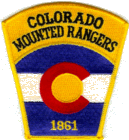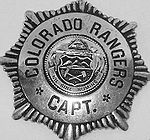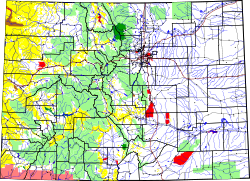- Colorado Mounted Rangers
-
Colorado Mounted Rangers Common name Colorado Rangers Abbreviation CMR Modern Day Shoulder Patch Captain's Badge - Circa 1920's CMR Badge - Circa 1960's Modern Day Badge, Gold for Squadron Officers, Silver for Rangers Motto Protecting and Serving Colorado Since 1861 Agency overview Formed 1861 Preceding agency Jefferson Rangers Volunteers Yes Legal personality Non government: Non-profit Jurisdictional structure Operations jurisdiction* State of Colorado, USA Map of Colorado Size 104,185 square miles (269,840 km2) Population 4,861,515 (2007 est.)[1] Legal jurisdiction As per operations jurisdiction. General nature - Law enforcement
- Civilian agency
Operational structure Rangers ~200 Cadets ~15 Parent agency Colorado Office of Emergency Management Notables Person - Edward P. Bell, Ranger, for being the only ranger to be killed in the line of duty.
Website http://www.coloradoranger.org/ Footnotes * Divisional agency: Division of the country, over which the agency has usual operational jurisdiction. The Colorado Mounted Rangers, or the Colorado Rangers, are the oldest statewide law enforcement organization in Colorado, organized in 1861.
Contents
History
Origin & Early Days
The Rangers trace their roots to the Jefferson Rangers, organized in 1859 to keep the peace in the unofficial Jefferson Territory during the Pikes Peak Gold Rush, often guarding shipments of gold coming out of the camps.[2] In 1861, the Colorado Territory was established, and the Rangers were reorganized as the Colorado Rangers. Rangers would serve as Colorado's only statewide law enforcement through the 1920s. The Colorado Rangers were fashioned after the well known Texas Rangers and often served both law enforcement and militia roles in the early days of the Colorado Territory.
Rangers, along with other Colorado volunteers were instrumental in the Battle of Glorieta Pass. This battle was key in stopping the Confederate advance towards the Colorado gold fields. This battle is now known as the "Gettysburg of the West" [3] During this time, Rangers were still upholding the law in Colorado as well. In 1862, Captain A.J. Gill, Commander of the Colorado Rangers, detailed his investigation of the murder of Conrad Moschel near present day Franktown in a letter to his superiors. In it he states that the culprits tried to make it appear that Native Americans were responsible, but Capt. Gill concluded from the evidence that local outlaws were to blame.[4]
After the Civil War, the Colorado Rangers returned in earnest to their law enforcement duties. From time to time the Rangers were also called upon by Colorado's Governors to keep the peace during times of civil unrest, natural disasters, and during a dispute in Cripple Creek during the violent Labor Wars in Colorado's mining towns.[5] In their duty to protect the Governor, Rangers were occasionally known as the "Governor's Guard". ( In March 1999, then Governor Bill Owens proudly acknowledged this fact in a letter to the Colorado Mounted Rangers.[6]) With the coming of Prohibition to Colorado, Rangers were once again called to enforce the laws of the State, serving as the statewide Prohibition Unit.
Fighting Organized Crime
Denver District Attorney Philip Van Cise also used the rangers to break up widespread organized crime and to fight corruption in Denver's City Hall in the early 1920s.
In 1922, Van Cise set up an independent investigation of the Blonger gang, secretly funded by a group of wealthy Denver citizens. On August 24, 1922, Van Cise used a special force of Colorado Rangers to capture 33 suspects in a single day. Fearing that Blonger's contacts within the Denver Police Department would tip off the gang once the first suspect was taken to jail, Van Cise detained the gang members in the basement of the First Universalist Church, where he was a member, until the sweep was complete.
With the help of the Colorado Rangers, 20 con men, including Lou Blonger, were convicted and sent to prison, effectively busting the "Million-Dollar Bunco Ring."
Death of Ranger Edward P. Bell
On Saturday night, October 14, 1922, Rangers Edward Bell and George Jennings received an anonymous telephone tip that a filling station west of Limon, Colorado was about to be robbed. Rangers Bell and Jennings immediately left Limon and headed towards the filling station. A short time later, passers-by found the two Rangers unconscious lying by the side of the road with massive injuries, their weapons and wallets missing.[7] They were taken to St. Luke's Hospital in Denver, however, Ranger Bell never recovered from his injuries, passing away on October 16, 1922. The facts of what actually happened were never officially determined, Ranger Jennings could not remember what had happened to the pair due to a head injury, though it was speculated that bootleggers in the area were responsible as Rangers Bell and Jennings had made several large raids on nearby stills in the preceding months.
Rangers disbanded
Having been called out to keep the peace during a mining strike in Cripple Creek in 1894, the Rangers came to be seen as being on the side of big business. This was complicated in the 1920s by the fact that the Commanding Officer of the Rangers, Gen. Pat Hamrock, also served as the Commander of the Colorado National Guard. It was the National Guard that had participated in strike breaking on behalf of business interests in the early 1900s during the Colorado Labor Wars, and subsequent incidents such as the Ludlow Massacre.
As public sentiment swayed in the 1920s, and as a result of campaign promises to organized labor and other interests, newly elected Governor William E. Sweet signed an executive order on January 29, 1923, cutting off funding and effectively disbanding the Rangers.[8] Many Rangers went on to serve in the Colorado Prohibition Unit, though without State Police powers. Four years later, after much debate, on April 1, 1927 Governor Billy Adams repealed the Department of Safety Act, thus officially disbanding the Colorado Rangers.
Rangers revived during coal strike
In an ironic twist, just seven months after signing legislation to disband the Rangers, Governor Adams found himself and the State of Colorado in need, and once again called out the remnants of the now defunct Colorado Rangers, many from the ranks of the State Prohibition Unit. On November 21, 1927, led by noted Ranger Louis Scherf, the Colorado Rangers responded to civil unrest during a mining strike at the Columbine Mine, near present day Erie, Colorado. Unfortunately, the confrontation between striking miners, mine security guards, and the Rangers quickly turned violent and six miners were killed in the ensuing skirmish. The unfortunate events of the day have come to be known as the Columbine Mine Massacre, though both sides dispute the actual events of the day. The Rangers were once again disbanded, ending a chapter in their history. This left Colorado without standing statewide police protection until 1935 when the Colorado State Highway Courtesy Patrol (later becoming the Colorado State Patrol) was formed.
Reorganized
Governor Teller Ammons called the Rangers to duty one more time. This time they were reorganized as an all volunteer unit, the Colorado Mounted Rangers. Although this group formed and functioned during Gov. Ammons term of office (1937–1939), they were not formally incorporated until February 21, 1941, organized with a single Troop in Bailey.
In 1955, with a growing role in civil defense, the Colorado Mounted Rangers changed their constitution to form a squadron of several troops throughout the state. Sheriff Rufus Jones of Teller County helped the original Bailey Troop organize the Rangers on a statewide basis. Rangers serve as an unpaid volunteer auxiliary to any agency that requests their assistance.
Colorado Mounted Rangers have responded and assisted in natural disasters across Colorado, such as the 1971 Blizzard in Kim, the Big Thompson Flood, the Black Ridge Fire, and the Hayman Fire.
While conducting search and rescue efforts, especially in the Southwestern part of the State, the Colorado Mounted Rangers have saved the lives of many lost and injured climbers, hikers, hunters, and mountain bikers.
Today's Rangers
Today, the Colorado Rangers / Colorado Mounted Rangers are an all volunteer force that assists any local, state, and federal law enforcement agency in Colorado. They train to the Colorado P.O.S.T. (Peace Officer Standards and Training) board standards. Rangers provide security in emergency situations, assist in search and rescue operations, and provide assistance to local, state, and federal law enforcement authorities as requested. Rangers are sworn to support the Constitution and laws of the United States and the State of Colorado.
Recognition
In 1999, Ranger Edward P. Bell was included in the Colorado Law Enforcement Memorial. He is the only Colorado Ranger to have been killed in the line of duty.
In 2001, The Colorado House of Representatives of the Sixty-third General Assembly, passed HOUSE RESOLUTION 01-1009 to recognize and honor the Colorado Mounted Rangers' years of service in the state of Colorado.
In 2002, The Colorado State Senate of the Sixty-third General Assembly, passed RESOLUTION 02-008 to recognize and honor the countless hours of service the Colorado Mounted Rangers have served the state of Colorado since 1861.
In 2004, Governor Bill Owens declared Feb. 21, 2004, "Colorado Ranger / Colorado Mounted Ranger Day" honoring the long tradition of service to the State of Colorado.
In 2011, Ranger Bell was enshrined at the National Law Enforcement Officers Memorial in Washington, D.C.
Present Troops
Troop H - Denver Metro - North
Troop K - Denver Metro - South
Mission of the Colorado Rangers / Colorado Mounted Rangers
"...Provide assistance to the people of Colorado by working in cooperation with local, state, and federal law enforcement agencies to assist with security, traffic and crowd control, search and rescue, and other similar functions ..."
Ranger Links
- [1] FEMA's Citizen Corps V.I.P.S. (Volunteers In Police Service) Colorado Mounted Rangers link
- [2] Denver Post, Oct. 1, 2000 - Rangers still serving State
- [3] Nov 2002 article in Police Magazine - Living Law Enforcement History
- Colorado Springs Gazette, Jul. 2, 2006 - Rangers Remain
- Durango Herald, May 14, 2009 - Colorado Mounted Rangers assist at Airport Emergency Drill
- Rangers participate in Emergency Exercise, Canon City Daily Record, Nov. 16, 2009
- Colorado Law Enforcement Officers' Association article on the Rangers - Fall 2010 Issue
- [4] Qualified Volunteer Organizations at the Colorado Division of Emergency Management website
- Official website
Similar Organizations
The terms Colorado Rangers and Colorado Mounted Rangers are registered trademarks (since 1941) [1] The Colorado Mounted Rangers/Colorado Rangers is an IRS registered 501(c)(3) non-profit organization incorporated in the state of Colorado and is tax exempt.
References
- ^ 2007 Population Estimates
- ^ Stone, Wilbur Fiske, E: The History of Colorado, Vol. 1, page 701. The S.J. Clarke Publishing Co., 1918.
- ^ Edrington, Thomas S., and Taylor, John, E: The Battle of Glorieta Pass: A Gettysburg in the West, March 26–28-1862. University of New Mexico Press, 1998
- ^ McClure, Dr Carleton Edward: The History of the Colorado Rangers, page 76. Carleton McClure, 1994
- ^ Brotherhood of Locomotive Engineers (U.S.) E: Locomotive engineers journal, Volume 56, Issues 1-6, page 414. Brotherhood of Locomotive Engineers Journal, 1922
- ^ McClure, Dr Carleton Edward: The History of the Colorado Rangers, page 149. Carleton McClure, 1994
- ^ McClure, Dr Carleton Edward: The History of the Colorado Rangers, page 80. Carleton McClure, 1994
- ^ Bechtel, H. Kenneth Bechtel, E: State Police in the United States: A Socio-Historical Analysis , page 125. Greenwood Press, 1995.
Categories:- Law enforcement agencies of Colorado
- Non government law enforcement agencies
- Colorado law
- Law enforcement organizations
- Organizations based in Colorado
- Colorado Territory
- Ranger organizations of the United States
Wikimedia Foundation. 2010.





